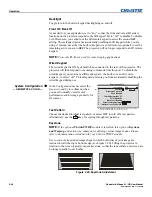
Operation
Roadster & Mirage S+/HD User Manual
3-31
020-100002-04 Rev. 1 (12-2008)
NOTES:
1)
Input levels apply for the current source only, but for any color
temperature used.
2)
Assuming that color temperature has been set up based on the
internal test patterns, you can then set up input levels for a given source so that it
matches the color temperature of the internal test patterns.
AUTO INPUT LEVEL –
Temporarily enter a checkmark
only
if you are an experienced
user and you have an unusual source that you feel needs further color temperature
and/or input level adjustment. This compensates for incoming out-of-range drives
(white) and blacklevels (black) that would cause “crushing” of light and dark colors
in the image. After entering a checkmark, wait for the six slidebar values to stabilize,
then delete the checkmark and exit. The Auto Input Level is automatically turned off
upon exit from the Input levels Menu.
BLACKLEVELS AND DRIVES –
To check your image levels and adjust these controls:
1.
Ensure overall “Contrast” and “Brightness” settings are both set to near 50.
NOTE:
Not required for “Auto” adjustment.
•
Contrast
= 50 (approx.)
•
Bright
= 50 (approx.)
2.
Check the color temperature setup using an internal grayscale test pattern,
making sure to obtain a neutral grayscale.
NOTE:
Not required for “Auto” adjustment.
3.
Confirm that you are using an analog source
not
connected to
INPUT 3
or
INPUT
4
, as Input Levels are not applicable for digital sources or sources going through
the decoder. A grayscale is recommended.
4.
If the blacks and/or whites appear OK, input levels do not need adjustment. If
black levels are too high (and/or whites are too low, which is rare), you likely
have a noisy source that is producing skewed input levels. Continue with Step 5.
5.
Temporarily enable “Auto” in the
Input Levels
submenu
.
Wait for all six values
to stabilize. Alternatively, do
not
use “Auto”—reduce blacklevels manually
instead. Judge by eye and change one or more of the six levels as necessary to
obtain proper blacks and whites. You may want to see only a certain color while
adjusting—use the “Color Enable” option (described below).
6.
Delete the “Auto” checkmark and leave the
Input Levels
menu.
IMPORTANT:
Do not use Input Levels to adjust color temperature.
This will
distort Contrast and Brightness functions as well as color temperature.
AUTO COLOR ENABLE –
When a checkmark is present, selecting a specific blacklevel
or drive to adjust will automatically enable the corresponding color in the display.
Delete the checkmark to see all colors, or to enable a different specific color through
the Color Enable Control.
CLAMP LOCATION –
This option (formerly known as
sync tip
clamping
) can brighten the image produced from certain high-
resolution high-frequency graphic sources. For almost all
sources, the projector automatically selects the best clamp
location. Use the normal
Back Porch
location if the image is either sufficiently bright
or overly bright. Select
Sync Tip
if the image appears unusually dim, if there are
horizontal streaks across the image, or if there is significant color drift. This moves the
clamping pulse from the normal back porch location (which is likely too short) to the
tip of the horizontal sync pulse.
Tri Level
is typically needed for an HDTV source.
















































